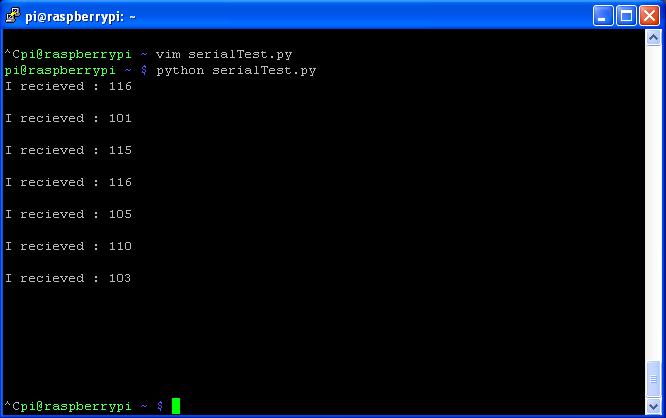

- #PYTHON READ SERIAL DATA FROM ARDUINO INSTALL#
- #PYTHON READ SERIAL DATA FROM ARDUINO CODE#
- #PYTHON READ SERIAL DATA FROM ARDUINO PC#
X=float(distance*math.sin(polar)*s(azimuthal)) Print('Serial Port is open : ' + ser.name) # Increment the line count, and stop the loop Print("Ignored invalid XYZ line: " + xyz_line) Is_valid = line.startswith("B") and line.endswith("E") import csv import serial Open com port ser serial.Serial ('COM4', 115200) with open ('datafile.csv', 'w') as newfile: csvwriter csv.writer (new.

For this reason, we choose arbitrarily to stop reading after 10 lines. # Check whether line starts with a B and ends In this case, since all the lines end with E, we don't have any way to know when to stop processing the lines. In this case, since all the lines end with E, we don't have any way to know when to stop processing the lines.
#PYTHON READ SERIAL DATA FROM ARDUINO INSTALL#
To install on Windows, simply visit PySerials Download Page and following the steps bellow : 1. # Convert the numbers from string format to integer PySerial is a Python API module which is used to read and write serial data to Arduino or any other Microcontroller. # We strip the E, and keep in mind that the serial

# If the line ends with E, we reached the last line You can also change the baud rate in line 3 of the Python program and line 2 of the Arduino program as long as they stay the same. Whatever that is should be what is in quotes in line 3 of the Python program. # Strip whitespace on the left and right side To determine what serial port your Arduino is connected to look at the bottom right corner of your Arduino sketch. With open("datafile.csv", "w") as new_file: In this case, we rely on seeing the letter "E" to know when to stop reading from the file. Each line starts with a B and ends with an E.The first line starts with a B, and the last line ends with an E.I will assume two approaches, depending on the format that is being sent by the Arduino board. Print('\n\nThis is the end of the file\n') In the first part of the article, I’ll describe how you can write an Arduino program that captures data from its sensors in the second part, I’ll describe how you can write a Python script that reads the Arduino’s data and writes it to a CSV file. With open('C:/Users/sylan/Desktop/Python/datafile.csv', 'w') as new_file: So far this is what I have done.Can any one point me to what to do next? Thank you for your time. csv file it will be something like x,y,z.
#PYTHON READ SERIAL DATA FROM ARDUINO PC#
Whereas the AngleV value is from 0-180,AngleH value is from 0-3600,distance value is from 0-4000.Īt the pc end, I want to read all 3 value in, then do some calculation and write it to the csv file: x = distance * sin(AngleV)*cos(AngleH)
#PYTHON READ SERIAL DATA FROM ARDUINO CODE#
Long pendulumEncoderCount = pendulumEncoder.I'm trying to write a code to read value from Arduino Uno every 2ms.Īt the Arduino end here is the code and what it will send every 2ms. Long cartEncoderCount = cartEncoder.read() Unsigned long currentMilliseconds = millis() Main.cpp #define ENCODER_OPTIMIZE_INTERRUPTSĮncoder cartEncoder(cartEncoderPhaseA, cartEncoderPhaseB) Įncoder pendulumEncoder(pendulumEncoderPhaseA, pendulumEncoderPhaseB) Ĭonst unsigned long TIMEFRAME = 100 // milliseconds Print("You have quit reading from the serial port.")Īrduino = Arduino("/dev/cu.usbmodem14101", baud_rate = 9400, timeout = 0) State_vector = _compute_state_vector(last_line_recieved)Ĭontrol_input = compute_input(state_vector) # Parse data into state_vector and compute control input using LQR Overflowed_digits = _check_for_overflowed_digits(decoded_line) # Sometimes digits overflow from one line onto the next If (len(serial_bytes) != 0) and (b'\n' in serial_bytes): # Read from serial until we capture the whole line of data rial = serial.Serial(port, baud_rate, timeout = timeout)ĭecoded_line = str(serial_code('utf8')) Check your Arduino IDE serial port for the exact location. You may also find yours there, or at an integer increment (ttyACM1, ttyACM2, etc.), or perhaps a different address completely. In the case of Raspberry Pi, the serial port (on my Arduino) is located at '/dev/ttyACM0'. State_vector =, state, state, state]Ĭontrol_input = -gain_matrix * state_vectorĭef _init_(self, port, baud_rate, timeout): These three simple lines read a single row of data from the serial port. 'cart_velocity': (data_array if '\r' not in data_array else data_array.split('\r')) # Sometimes the carriage return "\r" remains in the string, so get rid of it Overflowed_digits = ĭigits_to_string = ("").join(overflowed_digits) Return any(char.isdigit() for char in str(string))ĭef _check_for_overflowed_digits(string): What improvements can be made to my code? I feel like it is kind of bloated and can be better written, but I'm not sure which improvements should be made.

I am trying to send data from an Arduino into Python via USB every 100 ms.


 0 kommentar(er)
0 kommentar(er)
